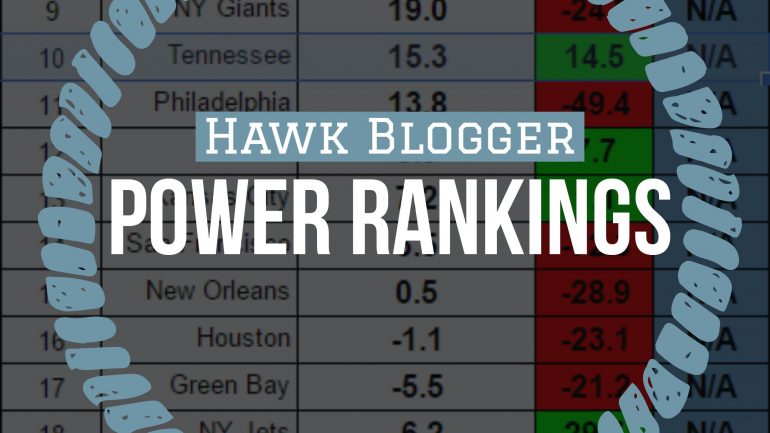The Seattle Seahawks remain in the top five for the second straight week, climbing up one spot to fourth in the rankings. It felt strange to see them there a week ago, as they have serious flaws on defense and on special teams, but the rankings formula rewards great quarterback play, and nobody has been better than Russell Wilson.
Seattle has the second-best passer rating differential in football, thanks in large part to Wilson’s league-leading 124.7 rating. They also picked off Baker Mayfield three times last week to help reduce their opponent passer rating to 86.3. Only the Patriots have a better differential than the Seahawks +38.4, as they are at +53.0.
Seattle has the lowest point differential (+3.2 ppg) of any team in the top ten outside of Detroit (+0.2 ppg). The Vikings, who are roughly equivalent to the Seahawks, have a +9.5 differential. Given the Seahawks weak schedule to this point, their inability to separate from teams remains a legitimate concern.
The Patriots have had the weakest schedule by far in the NFL, possibly historically weak, but they have outscored opponents by an average of 23.7 points per game. The 49ers have not had an easy schedule (roughly middle of the pack), and they have outscored opponents by an average of 16.8 points per game.
Seattle plays a Baltimore team this week that has lost much of its luster after a nuclear start against the Dolphins. They have lost a whopping 50.6 points of team strength in three weeks. They continue to have a strong offense, but that defense is rough. Not many would have predicted a shootout when the Ravens travel to Seattle this week, but that seems like a reasonable bet at this point.
In memoriam: We remember today the once-formidable Rams team. They rank 20th and show no signs of being able to recover from the depths of these rankings. It was a good run. Enjoy your franchise (snickers…) quarterback (chortles…) for years to come (erupts in laughter).

Rankings Visualization
This view shows tiers of strength that develop over the course of the season.

RANKINGS EXPLAINED
Power rankings are always debatable. I don’t buy into the gut feel methods most places use to determine their rankings, so I developed a formula a few years back that attempts to take at least some of the subjectivity out of the discussion. My approach was simple, I measured offensive and defensive efficiency based on the Yards Per Carry (YPC) and Yards Per Attempt (YPA), as well as points scored and points allowed. The formula to calculate “Team Strength” was as follows:
(YPC (offense) + YPA (offense) + Avg Pts/Game Scored) – (YPC (defense) + YPA (defense)+ Avg Pts/Game Allowed)
The formula has proven to be a pretty accurate predictor of success (roughly 70% of the teams ranked in the Top 10 by week 3 make the playoffs), but I am always looking for ways to improve it. I read a great article on ColdHardFootballFacts.com. There was one gem in there about predicting championship teams. The article mentioned passer rating differential as the “mother of all stats.” A full 69 of 72 champions have ranked in the Top 10 in this statistic. It is a stat after my own heart, as I believe offensive and defensive efficiency is the key measurable outside of point differential. Turnovers would factor in there as well, but I am not convinced a team has as much control over that. My power rankings use YPA and YPC differentials. I went ahead and replaced the YPA with offensive and defensive passer rating, to give me this:
(YPC (offense) + Passer Rating (offense) + Avg Pts/Game Scored) – (OPP YPC (defense) + OPP Passer Rating (defense)+ OPP Avg Pts/Game) As of September 23, 2014, I have added a strength of schedule component to the rankings as well. As of November 22, 2016, I have increased the weighting of the run game and point differential. Yards per carry will be multiplied by 10 to make it more evenly weighted with the passer rating. It is still roughly half as important, but will have a greater impact. Point differential will be multiplied by two as it still should be among the most important aspects of measuring teams.
